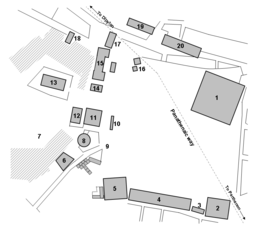Temple of Aphrodite Urania
The Temple of Aphrodite Urania (Greek: Βωμός Αφροδίτης Ουρανίας Vomós Afrodítis Ouranías) is a temple located north-west of the Ancient Agora of Athens, dedicated to the Greek goddess Aphrodite under her epithet Urania.[1]

Plan of the Ancient Agora of Athens. No. 18, north of the Hephaestion, is the Temple of Aphrodite Urania.
The temple was built around the early 5th century BC.
According to Pausanias,[2] the sanctuary had a marble statue of the deity sculpted by the ancient Greek sculptor Phidias:
- Above the Kerameikos [in Athens] is a sanctuary of the Aphrodite Ourania (Heavenly); the first men to establish her cult were the Assyrians, after the Assyrians the Paphians of Kypros and the Phoinikians who live at Askalon in Palestine; the Phoinikians taught her worship to the people of Kythera. Among the Athenians the cult was established by Aegeus, who thought that he was childless (he had, in fact, no children at the time ) and that his sisters had suffered their misfortune because of the wrath of Aphrodite Ourania (Heavenly). The statue still extant is of Parian marble and is the work of Pheidias. One of the Athenian parishes is that of the Athmoneis, who say that Porphyrion, an earlier king than Aktaios, founded their sanctuary of Ourania. But the traditions current among the Parishes often differ altogether from those of the city.[3]
If still in use by the 4th century, the temple would have been closed during the persecution of pagans in the late Roman Empire.
There are a few saved stones on the slope of the hill beside the train tracks and near the temple of her husband Hephaestus.
See also
References
- plato-dialogues.org/tools/agora.htm, URL accessed on June 2, 2008.
- Pausanias, I,14,7
- Pausanias, Description of Greece 1. 14. 6
This article is issued from Wikipedia. The text is licensed under Creative Commons - Attribution - Sharealike. Additional terms may apply for the media files.